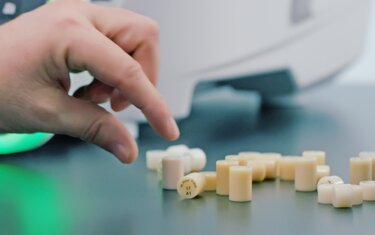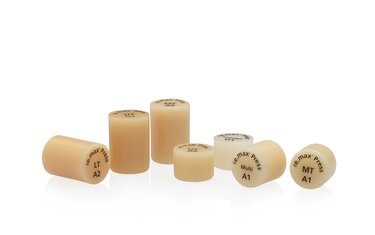We met up with Nicola Pietrobon in his laboratory in Zurich, Switzerland. The dental technician’s working relationship with Ivoclar goes back many years. Approximately 30 years ago, Nicola Pietrobon personally experienced the development of the press technology, quite by chance. We wanted to ask him about his memories of this exciting time and his enduring fascination with the technique. Robert Grünenfelder, Global Head of Furnaces at Ivoclar, spoke to him.
Nicola Pietrobon qualified as a dental technician in 1985. As a young technician he participated in an advanced training program at the University of Zurich between 1988 and 1990. This is where he met a very special person: Arnold Wohlwend.
The inside story of the press technology
What is so special about this man?
N. Pietrobon: “At that time, Arnold Wohlwend was the chief dental technician at the University of Zurich. During my studies, I worked with him on a daily basis. He was busy developing a process in which a viscous ceramic material could be shaped as desired. Once the shape is attained the ceramic would be hardened again. The idea as such was brilliant and I was impressed with how dedicated Arnold Wohlwend was in trying to achieve this goal. His innovative spirit was incredible as he undertook one experiment after the other.”
"Reinventing" how dental restorations are made also meant opening up new esthetic design opportunities. Furthermore, the demand for minimally invasive, metal-free restorations, which would help conserve healthy tooth structure, started to grow.
N. Pietrobon: “It was a long journey, which required much patience. The equipment that was needed was as yet unheard of in the dental industry. Consequently, Arnold Wohlwend worked with injection moulding equipment and ceramic furnaces from other industries. Countless attempts were necessary before his vision of the press technique as we know it today became a reality with the introduction of the first prototype. It was an incredible experience to have shared in the enormous joy and satisfaction of this achievement. I have very fond memories of those days.
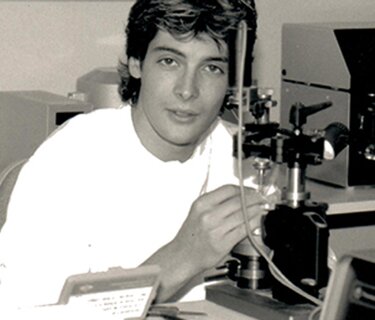
[Image above: N. Pietrobon in the training laboratory at the University of Zurich while participating in an advanced milling program]
In order to develop a reliable and marketable product the inventors decided to look for a partner in the dental industry who had the expertise that they needed. Ivoclar was prepared to provide the desired support and helped drive the further development of the product. The press technique was on its way.
The breakthrough for this revolutionary technique came in 1991 as a result of the untiring innovation efforts of Arnold Wohlwend and the Ivoclar development team. From then on it was possible to press viscous leucite ceramic materials into a hollow mould using a specially developed furnace (Programat). The mould was made in the lost-wax technique.
Thirty years have passed since the press technique reached market maturity. Nicola Pietrobon has been running his own dental laboratory with his business partner Reto Michel since 1998. Together with one other staff member they specialise in dental aesthetics.
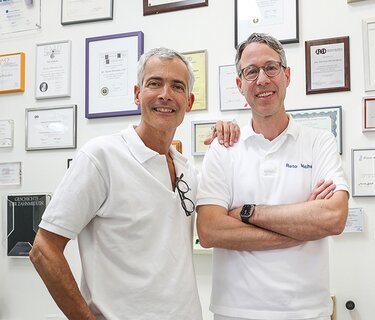
[Image above: Nicola Pietrobon (left) with his business partner Reto Michel in their jointly-owned laboratory.]
N. Pietrobon: “Right from the beginning we decided that our laboratory would focus on creating all-ceramic restorations. The press technique was indispensable to our work at that time and continues to be so to this day. Naturally, every system has its pros and cons. However, this is what makes our work so exciting: Every case requires a different solution, and it is our job to find it. I have always enjoyed having a craft as a profession. I love to see all the individual steps come together and culminate in a tangible outcome.”
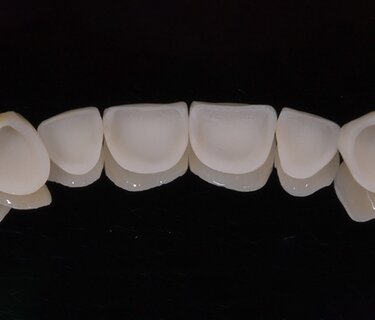
[Image above: Sample restoration fabricated by N. Pietrobon in collaboration with Dr. med. dent. Stefan Paul in Zurich. Crowns on canines for the re-establishment of proper canine guidance. Veneers on central and lateral incisors. Material: IPS e.max Press.]
N. Pietrobon: “I welcome smart devices as long as they do not impede my work. I am not interested in time-consuming gadgets because time is always at a premium in our business. Smart devices have to work reliably, save time and they must sound the alarm in case of an emergency. I do not expect anything more or anything less from smart solutions. Over the past few years, immense progress has been made in the development of the Programat ceramic and press furnaces. Initially, we were often faced with failures and we were unsure about whether or not the result would actually live up to our expectations. Today, using the hot-pressing technique is a ‘no brainer’ – due to the numerous intelligent features of the equipment, the excellent performance of the materials and the well-thought-out overall process.”
N. Pietrobon: “Young dentists in particular make use of digital technologies as a matter of course and they expect us technicians to do so too. Nevertheless, I think it is important for dental technicians to understand the manual aspects of their craft first, before they start to make use of digital possibilities. Digital workflows offer numerous advantages and they undoubtedly make our job easier. That said I like to use conventional techniques in certain cases – even though an equivalent digital option is available. We scan, mill and print – but at the same time we have great confidence in the press technique. Furthermore, I still prefer to make impressions by hand. I am quite certain that the press technique will continue to evolve. Now that this conventional technique can be combined with the printing process, it has taken the first major step towards digital transformation. The main aim will always be to find new ways of imitating natural teeth even more successfully. In all fairness, however, the quality and performance of the press technique are already extremely high.”
The press technique from Ivoclar has established itself as the original press method on the market. Its development is regarded as a milestone in the history of dentistry. The success achieved by this technology over the past few decades shows that it has found its place in dental laboratories and firmly convinced dental lab technicians*.
[Image below: The Programat press furnace has formed a part of the standard equipment of the Pietrobon&Michel Dental Laboratory for many years.]
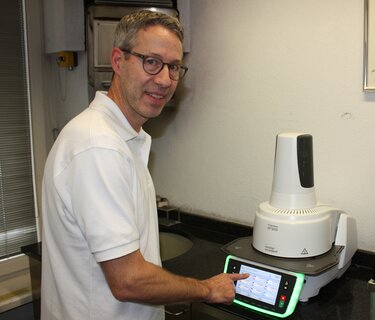
Get this product in our online shop
[1] Malament K A et al., J Prosthet Dent, 2021, 126, p. 533-545.
[2] Guess P C et al., J Dent, 2014, 42, p. 199-209
